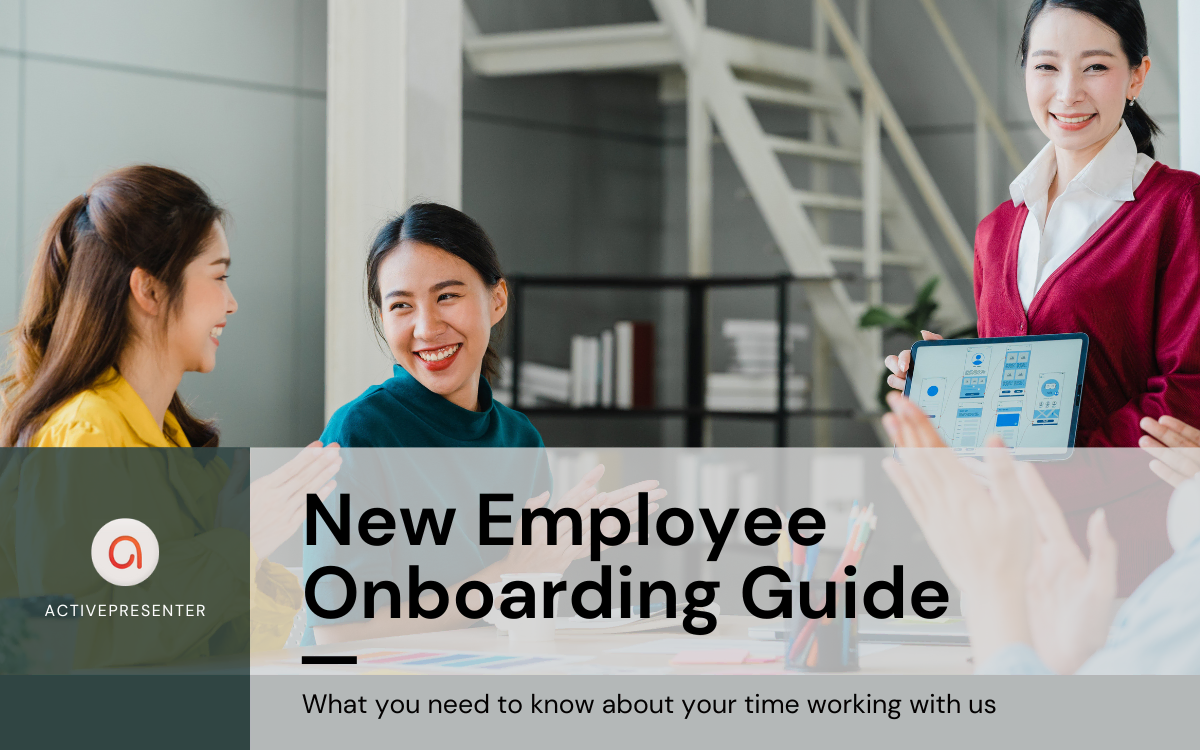Rapidly Create Employee Onboarding Process with These Methods
Employee onboarding is essential for both organizations and new hires. This blog post provides guidance on creating an effective onboarding process to quickly integrate new employees and boost their productivity.

Employee onboarding is an integral part of any organization, as it benefits not only the new hires but also the business leaders who strive to enhance employee engagement, boost productivity, and reduce turnover. New employees are keen to acquaint themselves with their job and gain a glimpse of their future work environment. Therefore, a well-designed onboarding program can bring advantages to both the employer and the employee. However, building an effective onboarding process from scratch can be a daunting task. Fortunately, there are ways to create this process.
Looking to create professional and engaging training videos? ActivePresenter is an exceptional choice. More than just a slideshow tool, it offers robust screen recording and advanced video editing capabilities, allowing you to easily capture software demonstrations, narrate processes, and cut/splice your footage. Crucially for training, ActivePresenter also lets you add interactive elements like quizzes, simulations, and branching scenarios, making your videos not just informative, but truly effective learning experiences. It’s a comprehensive solution designed to streamline the creation of high-quality, interactive training content.
What is Employee Onboarding and Why Do You Need It?
Employee Onboarding: Definition
The process of employee onboarding involves welcoming and integrating new employees into an organization through several activities. These activities help familiarize new employees with the company’s cultures, policies, and procedures as well as provide them with the tools and resources they need to complete their tasks.
Benefits of Employee Onboarding
The goal of employee onboarding is to help new hires feel comfortable and productive in their new roles. And this typically begins after a job offer has been accepted. The benefits of employee onboarding training include:

Steps to Build the Employee Onboarding Process
Step 1: Determine the Goals and Objectives of Your Onboarding Program
The first step in building an employee onboarding process is to determine the goals and objectives of the program. This involves defining what you want to achieve with the onboarding process. Some common objectives of onboarding include:

Once you have determined the goals and objectives of your onboarding program, you can move on to the next step.
Step 2: Build an Employee Training Program
The second step is to build an employee training program. A new employee training program can be created to meet the specific needs of an organization. But, it typically consists of two main parts.
Global training: serves as an employee handbook. It covers topics such as company culture, mission, core management team, and important rules and regulations.
Specific training: is designed for a particular role and includes fundamental training on core processes and systems related to the position.
By combining these two components, new hires can be equipped with the knowledge and skills necessary to thrive in their new roles and contribute to the organization’s success.
Step 3: Turn Classroom Activities into Interactive eLearning
Onboarding and training new employees in person can be time-consuming and expensive, particularly for large organizations with high turnover rates. As a solution, many organizations have begun moving their onboarding process online. eLearning programs for new hires offer several advantages, such as on-demand accessibility, reusability, and customization. This means that training can be accessed at any time, created once and used for all new hires with minimal updates required, and tailored to different employee types.
Below are some commonly used eLearning interactions in the employee training process:
Slide-Based Courses
Employee onboarding programs commonly use slide-based courses. In these courses, each slide consists of a combination of text, images, videos, and other multimedia components to convey information to the learner. The course can also include interactive elements such as quizzes, assessments, and simulations to help reinforce learning and engage employees. By providing a comprehensive overview of the organization, slide-based courses can help new employees feel more confident and prepared to succeed in their role.
Interactive Video Quizzes
To enhance an employee onboarding program, an interactive video quiz can be seamlessly incorporated. This can be done by creating a video that includes questions and scenarios related to the organization’s policies, procedures, and culture. The interactive element of the quiz allows new employees to test their knowledge and skills, as well as receive immediate feedback on their performance. This contributes to new employees identifying gaps in their knowledge or skill set, and empowers them to reinforce their learning.
Software Simulations
Imagine a virtual playground that allows new employees to master software applications or tools before using them in the real world. This is known as software simulation or interactive simulation. It’s a kind of interactive eLearning content that prepares employees for their role in a safe environment.
Dialogue Simulations
This interactive element of the employee onboarding program allows new employees to sharpen their communication skills. Especially in a secure and controlled environment, where mistakes are welcomed and valuable feedback is given instantly. The simulation includes a range of communication channels, from phone calls to live chats and even emails. This way provides new employees with a diverse set of challenges and feedback to help them improve.
Step 4: Deliver Content and Track Your Employees’ Progress
Picture this: You’ve created a perfect onboarding course. But now what? How do you get your new hires to experience it? The answer is a tool called a Learning Management System (LMS). This tool is designed to manage and deliver eLearning content and training programs. With an LMS by your side, you can assign courses to your new hires and track their results.
Wrapping Up
In conclusion, having a well-designed employee onboarding program is important to ensure new employees feel welcomed, valued, and prepared for their roles. With the various rapid eLearning methods we’ve discussed, such as slide-based courses, interactive video quizzes, software simulations, and dialogue simulations, creating an effective onboarding program has never been easier.
To take it to the next level, we recommend using ActivePresenter – a powerful eLearning authoring tool that can help you create engaging and interactive online training courses for employee onboarding. With ActivePresenter, you can not only easily create and customize training materials, insert multimedia elements, but also add quizzes and assessments, and track learners’ progress. Besides, its intuitive interface and extensive features make it an ideal choice for organizations of any size and industry.

In short, by integrating these rapid eLearning methods and using a tool like ActivePresenter, you can create a robust and effective employee onboarding program that helps new hires feel confident, and ready to succeed.
See Also:
